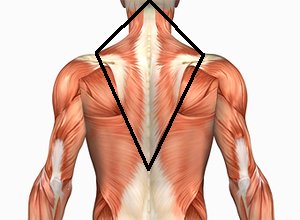The Traps
Thanks, Brock Lesnar!!
Big traps can be very intimidating, like "Boy that guy can shrug a lot of weight." or "I bet he can lift a very heavy suitcase." But they are also very functional beyond just posing for an odd senior portrait.
FUNCTION
Speaking of odd, the trapezius (or plural = trapezii) is the only muscle I can think of that has muscle fibers oriented such that the upper muscle has the opposite action as the lower muscle. Look closely at the illustration above, and see that the upper trapezius muscle fibers are oriented almost on the vertical plane above its insertion on the scapula, while the fibers of the lower trap are close to the vertical below the scapula. This means that contraction of one portion of the muscle leads to scapular elevation while shortening of the fibers of the lower trapezius leads to scapular depression. Of course, if you contract both areas with equal force, nothing will happen to the scapula, but that lends to another important function of the trapezii, stabilization of the scapula (and thus the shoulder). So this strange trapezoid muscle is very important in every movement of the scapula and for stabilizing the shoulder blade for movements of the upper arm. Take a look at this video to see the trapezius in action.
FORM
What this video also illustrates is the sheer size of the trapezius muscle, even if you don't have a WWE physique. This muscle extends from the base of the skull (occipital bone) down all the cervical and thoracic vertebrae to T12 (the last of the bones of the spine before the lumbar area). This medial side of the trapezius forms the origin of the muscle. Then all the muscle fibers converge in a triangular pattern to the lateral clavicle, acromion, and spine of the scapula. Don't get it? Just look below.
A trapezium is a convex quadrilateral with exactly one pair of opposite sides parallel to each other.
FITNESS
But enough geometry, let's get to the workout! As usual, this makes much more sense when you consider the aforementioned trapezius anatomy or form. We know that with any muscle, shortening of the muscle fibers brings the insertion closer to the origin. As an example, just think about your biceps contracting and bringing the forearm (insertion) closer to the origin of the biceps at the shoulder. The confusing part of the trapezius is that it has such a broad insertion along the midline of the cervical and thoracic spine, as well as three different insertions on the clavicle (collar bone), acromion (tip of the shoulder), and the spine of the scapula (shoulder blade). This translates into three different actions as follows:
Scapula and shoulder elevation
Scapular retraction (closer to the midline)
Scapular depression
In order to fully work the trapezii, you will need to perform all three actions, and if you haven't already guessed, the classic tons-of-weight-on-a-barbell shrug is just not going to do it. That lift only engages the upper trapezius (the only part you see looking in a mirror), and thus, in my opinion, should be relegated to the ancient past of bodybuilding lore. Overdeveloping this portion of the muscle will just lead to a constant shoulders-at-ears posture. So how do we appropriately build this muscle and avoid imbalance and poor posture???
The answer is, of course, find exercises that engage the whole trapezius, not just the upper. Below I've included, what I've found to be the best explanations of the trapezius and it's proper lifting techniques on the web.









